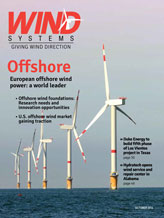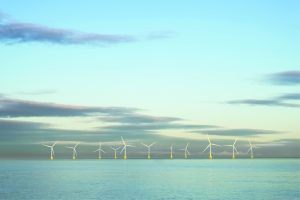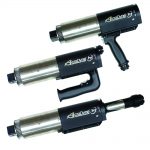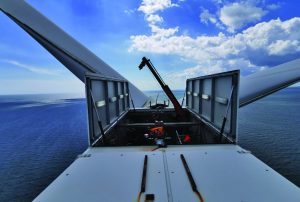Wind turbines have been turning in European seas since 1991, when the first offshore turbines were grid connected off the coast of Denmark. That was 23 years ago, and since then incredible progress has been made across the continent. At the end of June 2014, 7,343 MW of offshore wind power capacity was providing power to Europe — spread across 73 wind farms (with a total of 2,304 turbines) in 11 countries, capable of producing 27 TWh of electricity. That’s enough to meet the needs of over seven million households — or the entire population of the Netherlands.
Offshore wind is one of Europe’s fastest growing maritime sectors — by 2020 offshore wind could total 27.8 GW, meeting 3.5 percent of EU electricity demand or 102.2 TWh. The sector’s clear advantages of stronger, more consistent winds blowing at sea, and the fact that it does not put pressure on onshore sites — will continue to propel its growth, but the path to strong growth is not obstacle free.
Present State
In recent years wind energy in Europe has been buffeted by the economic crisis. According to The European Wind Energy Association’s latest statistics published this summer, during the first half of 2014 European offshore experienced a relative slow-down — new offshore capacity installations were down 25 percent compared to the same period the previous year. From January to July, 224 wind turbines were fully grid connected in the UK, Belgium, and Germany; 233 foundations were installed in 13 wind farms in Germany, the UK and Belgium; and 282 turbines were installed in eight wind farms in the same three countries. Meanwhile, preparatory work started at the 600 MW Gemini wind farm off the coast of the Netherlands.
The sector’s contraction may well continue into 2015 and 2016, depending on the outcome of political negotiations at EU level on climate and energy legislation for 2030. The EU is currently in the throes of setting a new agenda for Europe’s climate and energy policy, following on from Europe’s ambitious and legally-binding target of meeting 20 percent of the continent’s energy needs with renewable energy by 2020.
In order to ensure that healthy growth continues in the latter part of this decade, and to ensure that offshore wind energy plays its role in meeting the EU’s competitiveness, security, renewable and climate objectives, the industry needs longer-term visibility. An ambitious deal on the climate and renewable energy targets for 2030 — set to be agreed this October by EU Heads of State — would send a strong and positive signal of confidence to investors.
Needs for 2030
2020, the expiry date of the current EU renewable energy target, is just five years away. And yet, the EU wind energy sector would benefit from policy certainty that stretches way into the future. EWEA believes that Europe needs a strong target of at least 30 percent renewable energy by 2030 — and that that target should be legally binding at national level.
Offshore wind energy is an industry that creates jobs, reduces fossil fuel imports and one in which Europe is a world leader with huge export opportunities. The offshore wind sector currently employs 78,211 people, and this is expected to rise to 119,029 in 2020, according to the European Wind Energy Association’s figures. When it comes to setting an economically and environmentally ambitious agenda for Europe, we hope that EU leaders will think in the same forward-looking direction that the offshore sector is travelling in. Sidebar
But it’s not just political certainty that will move the sector into the future. The costs of offshore technologies need to become more competitive — and considerable investment in research and development in turbines, supply chains, grids, operations and maintenance is needed to help achieve cost reductions. Improved wind forecasting methods could also help make offshore wind farm development cheaper. Bringing down the costs of offshore wind power — and getting the industry to work together — will be a central tenet of the EWEA OFFSHORE 2015 conference to be held in Copenhagen next spring.
Financing Challenge
While political uncertainty is probably the greatest challenge facing offshore wind energy, there is yet another factor. The European offshore wind energy industry needs to attract between €50 billion and €69 billion over the next seven years to meet a target of 25 GW of offshore wind power.
On a European level, funding has been available. Power producers have so far been the main investors in offshore wind using their balance sheets. As the scale of investment grows, new entrants are becoming active in different aspects of project development. Engineering, procurement construction and installation companies, wind turbine manufacturers, oil and gas companies and corporate investors are already investing in offshore wind.
Moreover, innovative funding structures are now being used. The role of development banks and Export Credit Agencies has also been significant in attracting commercial lenders to the sector.
A Driving Force
Offshore wind energy in Europe is generally said to be 10-15 years behind its onshore counterpart. But, if it can overcome the political, economic, and financial obstacles, it can mirror the success of onshore wind power. Offshore wind can cut our dependence on fossil fuels, provide clean power and create sustainable jobs, together with onshore wind energy. Moreover, offshore wind has the power to turn-around areas in decline across Europe — especially those where shipbuilding was once a major employer.
Offshore wind is developing fast – at this moment in time the mass rollout of the next generation of offshore wind turbines is beginning to take place. And yet, the sector’s growth in the coming years hinges on the level of ambition that will be set by the EU’s leaders in the 2030 climate and energy package this autumn. Europe’s decision-makers need to capitalize on Europe’s first mover advantage and maintain the offshore wind momentum.
Next year, EWEA will host EWEA OFFSHORE 2015 in Copenhagen. Running from March 10–12, the event is set to attract thousands of offshore wind energy players from Europe and beyond. The buzz topic is set to center on how the offshore wind industry can think bigger on reducing the costs of wind energy across the entire supply chain. Meanwhile, the huge exhibition halls of the Bella Center will showcase the latest developments in the industry, and the 24 conference sessions will debate the very latest issues affecting the sector.
For more information, visit www.ewea.org/offshore2015.



































